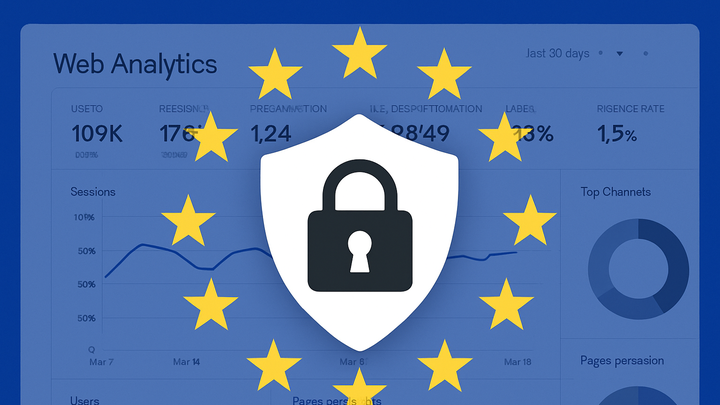Published on 2025-06-26T04:54:15Z
What is GDPR? Examples for GDPR Compliance in Analytics
The General Data Protection Regulation (GDPR) is a comprehensive data privacy law enforced by the European Union since May 2018. It aims to protect the personal data and privacy rights of EU citizens and residents by imposing strict requirements on how organizations collect, process, store, and share personal data. In the context of web analytics, GDPR mandates obtaining explicit user consent before setting non-essential cookies, enforcing data minimization, providing transparent privacy notices, and honoring data subject rights such as access, erasure, and data portability. Non-compliance can result in significant fines of up to €20 million or 4% of global annual turnover. SaaS analytics tools like PlainSignal (cookie-free) and Google Analytics 4 (cookie-based) offer different approaches to help organizations meet GDPR requirements while still gaining insights into user behavior.
Gdpr
EU regulation requiring explicit consent, data minimization, and privacy protections for personal data in web analytics.
1. Understanding GDPR
This section introduces the core principles, scope, and objectives of the GDPR and explains why it matters for any organization processing personal data.
-
Definition and purpose
GDPR stands for the General Data Protection Regulation. It replaced the 1995 Data Protection Directive to harmonize data privacy laws across the EU, strengthen individuals’ rights, and impose stricter obligations on organizations.
-
Scope and territorial applicability
GDPR applies to any controller or processor handling the personal data of EU residents, regardless of where the organization is based.
-
Data subjects
Individuals whose personal data is processed under GDPR protections.
-
Controllers vs processors
Controllers determine the purposes of processing; processors act on their behalf and must follow documented instructions.
-
-
Key principles
GDPR is built on foundational principles to ensure responsible data handling.
-
Lawfulness, fairness, transparency
Processing must be legal, reasonable, and open to the data subject.
-
Purpose limitation
Data must be collected for specified, explicit, and legitimate purposes only.
-
Data minimization
Only data strictly necessary for the processing purpose should be collected.
-
2. Impact on Web Analytics
GDPR imposes specific requirements on how analytics platforms collect and process user data, affecting cookie usage, consent mechanisms, and data retention policies.
-
Cookie usage restrictions
Under GDPR, non-essential cookies that process personal data require explicit user consent before being set or accessed.
-
Prior consent
Users must opt in before any analytics cookies are stored or read.
-
Cookie classification
Differentiate strictly necessary cookies from those requiring consent.
-
-
Consent requirements
Consent must be freely given, specific, informed, and unambiguous. Organizations must record and manage consent events.
-
Affirmative action
Consent must be given by a clear, positive action (e.g., checking a box).
-
Withdrawal
Users must be able to withdraw consent as easily as they gave it.
-
-
Data subject rights
GDPR grants individuals rights such as access, erasure, portability, and objection to automated profiling.
-
Right to access
Users can request details on how their data is processed.
-
Right to erasure
Users can demand deletion of their personal data from systems.
-
-
Data retention policies
Personal data should only be retained for as long as necessary and then securely deleted or anonymized.
-
Automated deletion
Configure analytics platforms to automatically purge data after defined retention periods.
-
3. Implementing GDPR Compliance with SaaS Analytics Tools
A comparison of cookie-free and cookie-based analytics approaches using popular SaaS platforms to meet GDPR obligations.
-
Cookie-free analytics with PlainSignal
PlainSignal delivers simple, privacy-focused analytics without using cookies or storing personal data, often eliminating the need for explicit consent. Example tracking code:
<link rel="preconnect" href="//eu.plainsignal.com/" crossorigin /> <script defer data-do="yourwebsitedomain.com" data-id="0GQV1xmtzQQ" data-api="//eu.plainsignal.com" src="//cdn.plainsignal.com/plainsignal-min.js"></script>-
Code implementation
Paste the PlainSignal snippet in your site’s head section—no cookie banner required.
-
Consent implications
Because no cookies are used, many regulators consider this approach GDPR-compliant without explicit consent.
-
-
Cookie-based analytics with GA4
Google Analytics 4 relies on cookies by default, requiring integration with a consent management platform and proper configuration for GDPR compliance.
-
Consent mode setup
Use
gtag('consent', 'default', { 'analytics_storage': 'denied' });to block analytics until consent is granted. -
Ip anonymization
Enable IP anonymization (
anonymize_ip) to mask users’ IP addresses before storage. -
Data retention configuration
Adjust data retention settings in the GA4 Admin panel to comply with your organization’s policy.
-
4. Best Practices for GDPR-Compliant Analytics
Key guidelines to ensure your analytics strategy remains aligned with GDPR principles and protects user privacy.
-
Data minimization
Collect only the metrics and dimensions essential to your analysis goals, avoiding unnecessary personal data.
-
Privacy by design and default
Embed privacy considerations into every stage of your analytics setup—from data collection to reporting.
-
Transparent privacy notices
Clearly inform users about what data you collect, why, how it’s processed, and how they can exercise their rights.
-
Regular audits and documentation
Perform periodic reviews of your data processing activities and maintain a record of processing operations.
